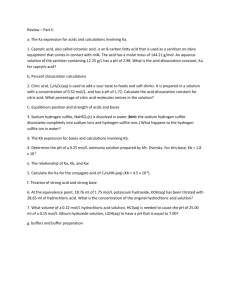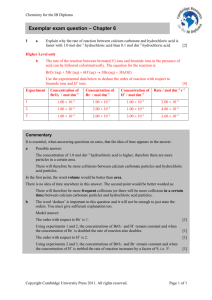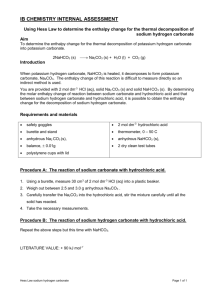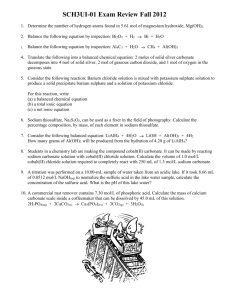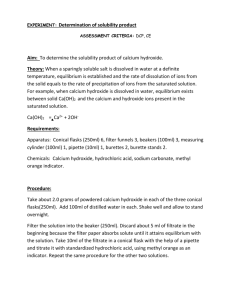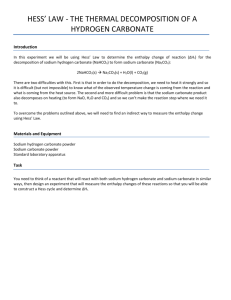chem2_1B_v2_feb15
advertisement
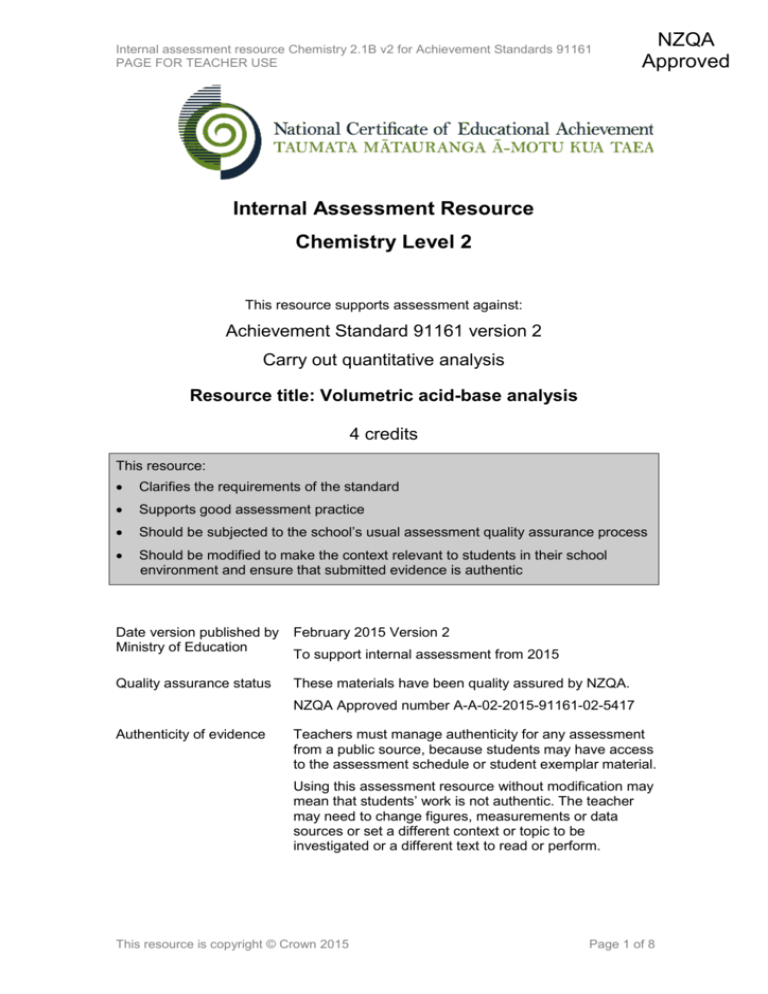
Internal assessment resource Chemistry 2.1B v2 for Achievement Standards 91161 PAGE FOR TEACHER USE NZQA Approved Internal Assessment Resource Chemistry Level 2 This resource supports assessment against: Achievement Standard 91161 version 2 Carry out quantitative analysis Resource title: Volumetric acid-base analysis 4 credits This resource: Clarifies the requirements of the standard Supports good assessment practice Should be subjected to the school’s usual assessment quality assurance process Should be modified to make the context relevant to students in their school environment and ensure that submitted evidence is authentic Date version published by Ministry of Education February 2015 Version 2 Quality assurance status These materials have been quality assured by NZQA. To support internal assessment from 2015 NZQA Approved number A-A-02-2015-91161-02-5417 Authenticity of evidence Teachers must manage authenticity for any assessment from a public source, because students may have access to the assessment schedule or student exemplar material. Using this assessment resource without modification may mean that students’ work is not authentic. The teacher may need to change figures, measurements or data sources or set a different context or topic to be investigated or a different text to read or perform. This resource is copyright © Crown 2015 Page 1 of 8 Internal assessment resource Chemistry 2.1B v2 for Achievement Standards 91161 PAGE FOR TEACHER USE Internal Assessment Resource Achievement Standard Chemistry 91161: Carry out quantitative analysis Resource reference: Chemistry 2.1B v2 Resource title: Volumetric acid-base analysis Credits: 4 Teacher guidelines The following guidelines are designed to ensure that teachers can carry out valid and consistent assessment using this internal assessment resource. Teachers need to be very familiar with the outcome being assessed by the Achievement Standard Chemistry 91161. The achievement criteria and the explanatory notes contain information, definitions, and requirements that are crucial when interpreting the standard and assessing students against it. Context/setting This activity requires students to carry out a volumetric acid-base analysis to collect primary data and process primary and secondary data to solve simple quantitative problems. Students will perform an acid-base titration to standardise a solution of acid, and calculate the concentration of the acid. They will then use provided data to solve simple quantitative problems. Although the context for this assessment is the common household cleaner sodium carbonate, the task is not specific to sodium carbonate and may be modified as appropriate for your setting, for example, vinegar, sulphuric acid, or caustic soda. Conditions Students should work individually on this assessment, in class. This assessment will require multiple sessions, for a total of approximately 2 hours of class time. Choose where to split the assessment resource and update the student instructions accordingly. The suggested time allowed is 1 hour for the practical part and 1 hour for the written part. You must accurately determine the solutions for the titration in advance (one of the requirements of the standard is accuracy). Carry out the procedure prior to the assessment and determine the expected titre for the sodium carbonate sample used. Give the students the concentration of the sodium carbonate solution (to 3 significant figures). Resource requirements Provide students with the following equipment: 20.0 or 25.0 mL pipette burette This resource is copyright © Crown 2015 Page 2 of 8 Internal assessment resource Chemistry 2.1B v2 for Achievement Standards 91161 PAGE FOR TEACHER USE 3 conical flasks standard hydrochloric acid solution (approximately 0.100 mol L1) sodium carbonate solution made by adding approximately 5.3 g anhydrous Na2CO3 to 1 L water distilled water methyl orange indicator wash bottle. Additional information When work is submitted to NZQA for external moderation, clearly identify the expected titre of sodium hydroxide solution needed in the titration and the corresponding concentration of hydrochloric acid. This resource is copyright © Crown 2015 Page 3 of 8 Internal assessment resource Chemistry 2.1B v2 for Achievement Standards 91161 PAGE FOR STUDENT USE Internal Assessment Resource Achievement Standard Chemistry 91161: Carry out quantitative analysis Resource reference: Chemistry 2.1B v2 Resource title: Volumetric acid-base analysis Credits: 4 Achievement Achievement with Merit Carry out quantitative analysis. Carry out in-depth quantitative analysis. Achievement with Excellence Carry out comprehensive quantitative analysis. Student instructions Introduction In this assessment, you will use quantitative analysis to determine the concentration of an unknown solution of hydrochloric acid. You will carry out an acid-base titration to standardise the hydrochloric acid using a known concentration of sodium carbonate. You will then solve simple quantitative problems relating to some household cleaners. You will be assessed on the accuracy of your titration data and calculations. Hydrochloric acid is highly reactive; working with unknown concentrations of HCL can be dangerous. Quantitative analysis of the reaction between sodium carbonate and hydrochloric acid can help you determine the concentration of the hydrochloric acid solution. Sodium carbonate has been used for generations as a household cleaner; it is now regaining its popularity as a ‘green’ cleaning substance. Na2CO3 reacts with hydrochloric acid, HCL. The equation for this reaction is Na2CO3 + 2HCl 2NaCl + CO2 + H2O Teacher note: This task is not specific to sodium carbonate and hydrochloric acid. You many modify the context as appropriate for your setting, for example, vinegar, sulphuric acid, or caustic soda. All work should be done individually, in class. You may need more than one session to complete this assessment, depending on the availability of equipment and the length of each class period; confirm the timeframe with your teacher. Teacher note: You should confirm the assessment timeframes with your students before conducting the assessment. This resource is copyright © Crown 2015 Page 4 of 8 Internal assessment resource Chemistry 2.1B v2 for Achievement Standards 91161 PAGE FOR STUDENT USE Task Part A: Practical activity Working on your own, use the equipment provided by your teacher to titrate 25.0 mL of sodium carbonate solution of known concentration with hydrochloric acid until you have at least three concordant titres. Record your titre volumes to 2 decimal places. Using your primary data (the titre volumes) and your knowledge of stoichiometry (the relationships between reactants and products), calculate the concentration of hydrochloric acid in the unknown solution. Show all of your working, and give answers to three significant figures, with units. You will need: 25.0 mL pipette burette 3 conical flasks diluted hydrochloric acid solution sodium carbonate solution (Concentration = _______mol L-1) distilled water methyl orange indicator wash bottle. Results Teacher note: Leave sufficient space for students to write their answers. Calculations Calculate the average volume for hydrochloric acid. Teacher note: Leave sufficient space for students to write their answers. Use the known concentration of sodium carbonate to calculate the amount, in moles, of hydrochloric acid. Teacher note: Leave sufficient space for students to write their answers. Calculate the concentration of hydrochloric acid in the unknown solution used in the titration. Give your answer to three significant figures. Teacher note: Leave sufficient space for students to write their answers. This resource is copyright © Crown 2015 Page 5 of 8 Internal assessment resource Chemistry 2.1B v2 for Achievement Standards 91161 PAGE FOR STUDENT USE Part B: Written activity Tile cleaners contain hydrogen peroxide. Hydrogen peroxide is 94.12% oxygen and 5.88% hydrogen. It has a molar mass of 34.0 g mol-1. Use the following molar masses to calculate both the empirical formula and the molecular formula of hydrogen peroxide. M(C) = 12.0 g mol-1 M(H) = 1.00 g mol-1 M(O) = 16.0 g mol-1 M(Na) = 23.0 g mol-1 Teacher note: Leave sufficient space for students to write their answers. Citric acid, formula C6H8O7, can be used to soften water which makes it useful in soaps and laundry detergents. Calculate the percentage composition of citric acid. Teacher note: Leave sufficient space for students to write their answers. Citric acid reacts with sodium hydroxide. The equation for the reaction is: C6H8O7 + 3NaOH → C6H5O7Na3 + 3H2O Calculate the mass of sodium citrate, C6H5O7Na3, which is formed when 10.0g of sodium hydroxide reacts with citric acid. Teacher note: Leave sufficient space for students to write their answers. This resource is copyright © Crown 2015 Page 6 of 8 Internal assessment resource Chemistry 2.1B v2 for Achievement Standards 91161 PAGE FOR TEACHER USE Assessment schedule: Chemistry 2.1B Volumetric acid-base analysis Required information from the teacher: Standard sodium carbonate solution concentration n = [insert value, for example 0.0495] mol L1, Expected titre = [insert value, for example 22.70] mL. Evidence/Judgements for Achievement Evidence/Judgements for Achievement with Merit Evidence/Judgements for Achievement with Excellence Student correctly: records initial and final volumes of hydrochloric acid used in the titration – at least three titres fall within a range of 0.4 mL calculates average titre value to within 0.8 mL of the expected titre, using all titre values uses the relationships n=m/M and c=n/V to calculate one variable given the other two, for example, the student determines the number of moles of sodium carbonate based on the given concentration and measured volume: n(Na2CO3) = 0.0495 x 0.025 = 1.24 x 10-3 mol. A minor error in calculation is allowed as long as the procedure is appropriate, for example, an incorrect conversion from mL to L. Units and 3 significant figures are not required for achieved, however, titre volumes should be given to at least 2 decimal places. Student correctly: records initial and final volumes of hydrochloric acid used in the titration – at least three titres fall within a range of 0.4 mL calculates average titre value to within 0.5 mL of the expected titre, using only concordant titre values uses the relationships n=m/M and c=n/V to solve problems involving at least 2 steps, for example, the student determines the number of moles of hydrochloric acid based on the measured titre volume: n(Na2CO3) = 0.0495 x 0.025 = 1.24 x 10-3 mol. n(Na2CO3) : n(HCl) = 1:2, so n(HCl) = 2.47x 10-3 mol. Student correctly: records initial and final volumes of hydrochloric acid used in the titration – at least three titres fall within a range of 0.2 mL calculates average titre value to within 0.2 mL of the expected titre, using only concordant titre values uses the relationships n=m/M and c=n/V to solve stoichiometric problems involving more than 2 steps, for example, the student determines the concentration of hydrochloric acid: n(Na2CO3) = 0.0495 x 0.025 = 1.24 x 10-3 mol. n(Na2CO3) : n(HCl) = 1:2, so n(HCl) = 2.47x 10-3 mol. c(HCL) = 2.47x 10-3 mol / 0.0227 L = 0.109 mol L-1. Units and 3 significant figures are required for excellence. Mass of sodium citrate correctly calculated Example: n(NaOH) = 10/40 = 0.250 mol n(NaOH) : n(C6H5O7Na3) = 3:1 n(C6H5O7Na3) = 0.250/3 = 0.0833 mol m(C6H5O7Na3) = 0.0833 x 258 = 21.5g Consistent use of significant figures and correct units This resource is copyright © Crown 2015 c(HCl) = 2.47X10-3/0.0227 = 0.109 mol.L-1 Units and 3 significant figures are not required for merit. Titre volumes should be given to 2 decimal places. Empirical and molecular formulae are calculated Example: n(H) = 5.88/1.00 = 5.88 mol n(O) = 94.12/16.0 = 5.88 mol empirical formula = HO M(HO) = 17g.mol-1 therefore Page 7 of 8 Internal assessment resource Chemistry 2.1B v2 for Achievement Standards 91161 PAGE FOR TEACHER USE Molecular formula = H2O2 Percentage composition is calculated Example: %C = 72.0/192 (x100) = 37.5% %H = 8.0/192 (x100) = 4.20% %O = 112/192 (x100) = 58.3% Two correct steps of the calculation are shown. Final grades will be decided using professional judgement based on a holistic examination of the evidence provided against the criteria in the Achievement Standard. This resource is copyright © Crown 2015 Page 8 of 8


